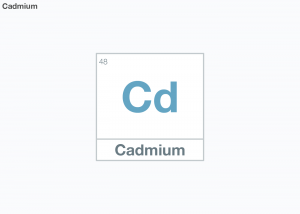SedimentCadmium (mg/kg dry weight)
|
MusselsCadmium (mg/kg wet weight)
|
|
|---|---|---|
|
|
North |
|
| South |
What is it?
Cadmium is a naturally occurring heavy metal, found in soil, rock, and marine and freshwater sediments. It can enter the environment via both natural and anthropogenic processes. Natural sources of cadmium include forest fires, volcanic emissions, and weathering of soil and rock. Anthropogenic sources include metal smelting and refining, fuel combustion in power generation and heating, pulp and paper production, metals processing, and wastewater treatment.1 Phosphate fertilizers can also have high cadmium levels.2
FACT: Naturally-occurring cadmium is found at elevated levels in shellfish at temperate latitudes in the NE Pacific.
Cadmium is used primarily in nickel-cadmium batteries, as well as in protective metal coatings, pigments, and stabilizers.3 Cadmium is also found in cigarettes, and, for smokers, inhalation of cigarette smoke is a significant source of cadmium relative to other potential exposure routes (e.g., diet, environment).3

How does it get into the ocean?
Cadmium enters the marine environment through atmospheric deposition as well as wastewater and industrial discharges.4
Cadmium and cadmium compounds are relatively water soluble compared to other heavy metals, making them more bioavailable and bioaccumulative.4 In sea water, cadmium has a strong tendency to desorb from sediments and resuspend in the water column.5 It is readily accumulated by marine organisms, particularly plankton and invertebrates.4
Is it a problem?
Cadmium has no known biological function. In humans, cadmium accumulates primarily in the liver and kidneys, but unlike many other metals, it can also accumulate in the placenta. Cadmium is classified as a human carcinogen, and is also toxic to the renal, endocrine, and reproductive systems.6 At a cellular level, cadmium can interfere with DNA repair, causing genotoxicity.6
In fish, the embryonic and early larval stages are most susceptible to cadmium toxicity, with long term exposure resulting in larval mortality and reduction in growth.7 Effects on adult fish include spinal malformations, changes in behaviour, and decreased thyroid function.8 Salmonids have been shown to be particularly susceptible to cadmium toxicity.4
Seabirds have been observed to accumulate high cadmium levels, as have ringed seals.8 Kidney damage in pelagic sea birds has been observed as a result of high cadmium concentrations.9
Most cadmium is excreted by terrestrial animals and does not accumulate in muscle tissue (meat) or biomagnify in the food chain. However, as cadmium does accumulate in the liver and kidney, consumption limits for wild organ meats have been set by some regions in Canada (e.g., Yukon Government).3
What is being done?
Federal and provincial environmental quality guidelines protective of marine aquatic life are available for cadmium in sediment and seawater (Table 1).11,12 Sediment quality guidelines are derived from toxicity endpoints in benthic invertebrates and, therefore, are not specifically protective of birds and marine mammals. Water quality guidelines are based on toxicity data for fish, invertebrates, and plants.
Table 1. Canadian and British Columbia Marine Environmental Quality Guidelines for Cadmium 11,12
Historically cadmium had few uses in consumer products, but after the introduction of strict limits on lead, cadmium was increasingly used as a substitute. For example, cadmium is now widely used in costume jewellery. In 2018, Health Canada amended the Children’s Jewellery Regulations, which reduced exposure to cadmium (and lead) if jewellery was chewed on or swallowed by a child.10
What can you do?
As individuals and organizations, we can:
- Learn more about cadmium and other toxic metals using the resource links below
- Recycle and dispose of waste responsibly and according to local guidelines (e.g., cadmium-containing rechargeable batteries should be recycled, not put in the landfill).
More Information?
1 Environment and Climate Change Canada (ECCC). 2016. Canadian Environmental Sustainability Indicators. Releases of Harmful Substances to the Environment. Available at: https://www.canada.ca/en/environment-climate-change/services/environmental-indicators/releases-harmful-substances-water.html
2 Godt J, Scheidig F, Grosse-Siestrup C, Esche V, Brandenburg P, Reich A, Groneberg DA. 2006. The toxicity of cadmium and resulting hazards for human health. Journal of Occupational Medicine and Toxicology 1:22.
3 Government of Yukon, 2021. Hunt Wisely, A guidebook for hunting safely and responsibly in Yukon. 54 pp. Available at: env-hunt-wisely.pdf (yukon.ca)
4 Nordic Council of Ministers (NCM). 2003. Cadmium Review. Report No. 1, Issue No. 4. Copenhagen. 26 pp. Available at: Cadmium Review (who.int)
5 Simpson WR. 1978. A critical review of cadmium in the marine environment. Report No. 44, Institute of Oceanographic Sciences, Surrey. 168 pp.
6 Rani A, Kumar A, Lal A, Pant M. 2014. Cellular mechanisms of cadmium-induced toxicity: a review. International Journal of Environmental Health Research 24: 378-399.
7 Arctic Monitoring and Assessment Programme (AMAP).1998. AMAP Assessment report: Arctic pollution issues. Arctic Monitoring and Assessment Programme, Oslo, Norway. xii+859 pp. Available at: AMAP Assessment Report: Arctic Pollution Issues. | AMAP
8 Arctic Monitoring and Assessment Programme (AMAP). 2002. Arctic Pollution 2002: Persistent Organic Pollutants, Heavy Metals, Radioactivity, Human Health, Changing Pathways. Arctic Monitoring and Assessment Programme, Oslo, Norway. xii+ 112 pp. Available at: Arctic Pollution 2002 | AMAP
9 World Health Organization (WHO). 1992. Cadmium – environmental aspects. Environmental Health Criteria 135. World Health Organisation, International Programme on Chemical Safety (IPCS), Geneva, Switzerland.
10 Health Canada. 2021. Industry Guide to Children’s Jewellery. Available at: Industry Guide to Children’s Jewellery – Canada.ca
11 Canadian Council of Ministers of the Environment (CCME). 1998. Canadian sediment quality guidelines. Canadian Council of Ministers of the Environment, Winnipeg. Available at: http://ceqg-rcqe.ccme.ca/en/index.html#void
12 British Columbia Ministry of Environment and Climate Change Strategy. 2021. Working Water Quality Guidelines: Aquatic Life, Wildlife & Agriculture. Water Quality Guideline Series, WQG-08. Prov. B.C., Victoria B.C. Available at: bc_env_working_water_quality_guidelines.pdf (gov.bc.ca)